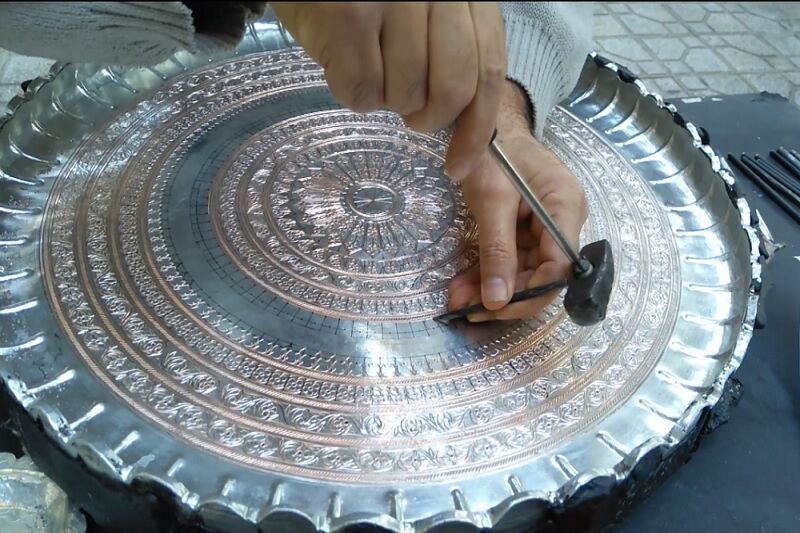One of the branches of Iranian handicrafts] is the art of engraving. The history of this art in our country is not known and dates back to several thousand years BC. The art of engraving existed during the Achaemenid period and flourished during the Sassanid period. This art is the art of carving and hammering patterns on metals such as gold, silver, copper and brass. Engraving is a branch of metalworking in handicrafts.
This art is very common in Isfahan and is very prosperous. In this city, the patterns of flowers and chickens, verses of the Quran and Ashgar are engraved on rice, silver and copper, engraving and engraving.
A variety of engraving styles
There are 3 styles in the art of engraving, which we mention below:
1- Shiraz style
This style is specific to Shiraz. In this way, it is mostly done on silver metal and Achaemenid and Sassanid roles and designs and chicken flower designs are used. Engraving in this style is done in two ways. This style has been popular in the Saqqavian and Zandian periods.
2- Isfahan style
There are two types of engraving in Isfahan style. Which is called fine engraving and embossing. In embossed engraving method, it is more prominent in nature and has a three-dimensional shape.
3- Tabriz style
Tabriz style also has its own method. In this style, instead of pressing on hammer blows, the most pressure is on the wrist. And this makes this engraving style not have less depth than Isfahan engraving.

Engraving methods
1. Embossing
The steps in highlighting work are that, first, they work on the back surface and transfer the design. After half of this, the bitumen is removed from the work and the desired container is highlighted using special pens.
۲. Semi-embossed
This method is different. In this way, ordinary pens are used for work. They also highlight the work from the opposite side and the surface appears by bringing the background. This method is different. In this way, ordinary pens are used for work. They also highlight the work from the opposite side and the surface appears by bringing the background.
3. A small pen
In this method, bitumen is transferred and the design is transferred, but this method is not a prominent pen. In this method, floral, chicken and Islamic designs are used.
4. Engraving
In the engraving method, the engraving is done with only one pen.
5. Lattice work
This method is very different from other methods. In this method, the background is separated from the metal surface and work is done on it. This method is old. And was mostly used to build lanterns and water crossings.

How and how to engrave
n the art of engraving, bitumen must first be applied to the back of the metal surface to be engraved. The reason for doing this is that it does not warp due to the hammer blows, it also prevents it from making a lot of noise.
It should be noted that melted bitumen is used in this stage of work. After doing this, the desired surface of the white grout metal should be applied to make our design and role more clear.
After the role is transferred to the work, there is a tool called a half-bar, which is also called a pen, with which the lines are drawn. Continuation of the design is decorated with special pens. The name of these pens is wicker pen, engraving, greed, sambeh, one, half, thick, flat floor and ،, which has a role on this pen that is consistent with its name. . Then, when the engraving is finished, it is removed from the back of the work using heat, and if there is still bitumen in the work, it is cleaned with oil. It is soldered and soldered. This soldering is done using tin.
In the continuation of the work, a wooden or leather hammer is used to smooth and flatten the container. After finishing the work, the container should be transferred to the polishing workshop for payment.
At this stage, it is cleaned with soap and a work brush. After that, special wax or soot is applied to further polish it. The last stage of engraving is blackening. In this way, the engraved surface is covered with soot and wax. This causes the parts of the furrow to be filled with this material. With this part, the main color of the metal becomes prominent and the sunken parts are black. It works with polish and beauty.




